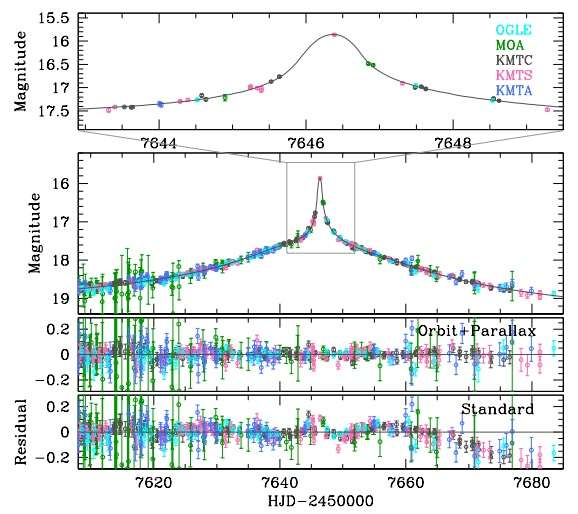May 23, 2017 report
Binary star composed of two brown dwarfs discovered by microlensing

(Phys.org)—Using gravitational microlensing, astronomers have recently found a binary star composed of two brown dwarfs. The newly discovered system is the third brown-dwarf binary detected with this technique. The finding was presented in a paper published May 16 on the arXiv pre-print server.
Gravitational microlensing is an invaluable method of detecting new extrasolar planets and brown dwarfs, regardless of the light they emit. This technique is therefore sensitive to the mass of the objects, rather than their luminosity, which allows astronomers to study objects that emit little or no light at all. Hence, due to their extremely low luminosities, brown-dwarf systems seem to be ideal targets for microlensing observations.
Now, a team of astronomers led by Cheongho Han of the Chungbuk National University in Cheongju, South Korea, reports the detection of a new brown-dwarf binary system from the analysis of the microlensing event OGLE-2016-BLG-1469. The discovery is the result of a joint effort of over 50 scientists working in three microlensing research groups. The team consists of researchers from the Korea Microlensing Telescope Network (KMTNet), the Optical Gravitational Lensing Experiment (OGLE) and the Microlensing Observations in Astrophysics (MOA).
"In this paper, we present the microlensing discovery of another binary system composed of brown dwarfs," the astronomers wrote in the paper.
For their observations of OGLE-2016-BLG-1469, MOA researchers employed the 1.8m telescope at the Mt. John University Observatory in New Zealand, while OGLE scientists used the 1.3m telescope located at the Las Campanas Observatory in Chile. When it comes to KMTNet, the astronomers utilized three identical 1.6m telescopes located at the Cerro Tololo Inter-American Observatory in Chile, the South African Astronomical Observatory in South Africa, and the Siding Spring Observatory in Australia.
All these ground-based observatories located worldwide allowed the team to find that the light curve of the microlensing event showcased a short-term central anomaly. This irregularity turned out to be produced by a binary companion with a mass roughly equal to the primary.
More importantly, the researchers were able to determine the mass of both brown dwarfs and estimate their projected separation. They found that the mass of one of the newly discovered objects is about 0.05 solar masses, while the second one has approximately 0.01 the mass of the sun. The projected separation between the binary components was estimated to be 0.33 AU. Moreover, the study revealed that the system is located about 14,670 light years away from the Earth.
"By measuring both the angular Einstein radius and the microlens parallax, we could uniquely determine the masses and identified the substellar nature of the lens components," the paper reads.
According to the authors of the paper, their discovery shows the importance of the microlensing technique when it comes to finding new brown-dwarf binary systems.
"The lens was the third microlensing brown-dwarf binary with measured mass, demonstrating the usefulness of the microlensing method in detecting field brown-dwarf binaries," the researchers concluded.
More information: OGLE-2016-BLG-1469L: Microlensing Binary Composed of Brown Dwarfs, arXiv:1705.05553 [astro-ph.SR] arxiv.org/abs/1705.05553
Abstract
We report the discovery of a binary composed of two brown dwarfs, based on the analysis of the microlensing event OGLE-2016-BLG-1469. Thanks to detection of both finite-source and microlens-parallax effects, we are able to measure both the masses M1∼0.05 M⊙, M2∼0.01 M⊙, and distance DL∼4.5 kpc, as well as the projected separation a⊥∼0.33 au. This is the third brown-dwarf binary detected using the microlensing method, demonstrating the usefulness of microlensing in detecting field brown-dwarf binaries with separations less than 1 au.
© 2017 Phys.org





















